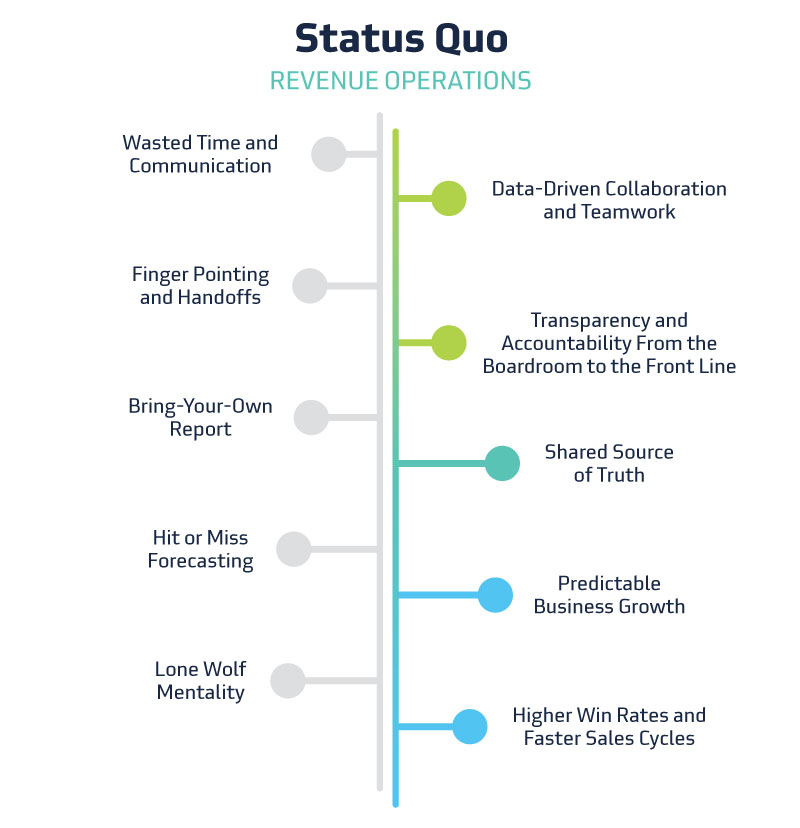Why B2B Companies Should Explore Revenue Operations Strategies
 Taylor
|
Taylor
|

Strategic alignment between departments is necessary to grow and scale operating revenue.
For a very long time, a hot topic of conversation for B2B businesses has been sales and marketing alignment. We've worked with numerous companies over the years and discussed how to help each team work better together. The coordination and strategic alignment between these two departments have been necessary for B2B leaders to continue growing and scaling at the speeds they want.
And for many companies, sales and marketing alignment efforts have been around for a while. But, as we continue to move forward and look toward trends for the future, customer service and support must become a part of this conversation.
The importance of customer experience and service roles have grown in importance over the past few years, and that isn't anything that will be going away soon. If your sales and marketing organizations are already working well together and you're ready to get intentional and strategic in support, better servicing your customer's revenue operations may be the next step in optimizing your processes.
What is Revenue Operations?
Revenue operations, also known as RevOps, is a relatively new concept. But, don’t let its newness fool you. It’s catching on fast. According to the LeanData State of Revenue Operations, there was a 55% increase in revenue operations adoption from 2018 to 2019. Additionally, in 2018, Director of Revenue Operations job titles surpassed Director of Sales Operations by 68% on LinkedIn.
RevOps is the strategic integration of sales, marketing, and service departments to give a better end-to-end view to leadership teams while leaving day-to-day processes within departments. This approach helps break down traditional silos between sales, marketing, and service departments. RevOps strategies can give you the processes and strategies you need to make your business run like a well-oiled machine.
Where Did Revenue Operations Come From?
The ultimate goal of revenue operations is the accountability and harmony of departments within a business that are responsible for driving revenue — which typically includes sales, marketing, and customer service.
Over the years, there has been a profound shift in how companies think about operating revenue processes. Business leaders are becoming more transparent, accountable, and predictable all the way from front lines to the board room.
Part of this shift has come from the change in buyer behavior. B2B buyers specifically spend more time on their own research well before they ever contact a salesperson. Plus, subscription-based business models mean what happens after the sale is just as important as what happens before. This shift has caused teams responsible for driving revenue to be aligned throughout the entire sales funnel.
There are four common reasons we typically reference in the rise of RevOps teams and strategies:
- Disconnected and outdated revenue data causing inefficiencies and inaccuracies across revenue teams
- New development in automation systems to drive insights for every level of the revenue team
- Customer expectations of a completely seamless buyer's journey
- The need for transparency and accountability from the boardroom to the front line to achieve business initiatives
An evolution to processes for B2B and manufacturing teams
When working with B2B businesses, we often see sales teams, marketing teams, and customer service teams relying on separate tech software and processes (CRM, spreadsheets, business intelligence, and automation), leading to big disconnects in efforts and data alignment. This mismatched data results in frustration and confusion.
But there’s a better way.
Essentially, sales and marketing alignment comes down to the communication between the two. When they have a clear delineation of work and have open, frequent communication with one another, their efforts are complementary instead of contrasting or duplicative.
With RevOps picking up steam, the next phase of the evolution of traditionally siloed team structures is here. In a way, it’s replicating that idea of sales and marketing alignment to now include all teams responsible for revenue. It’s focused on moving teams away from wasted time, finger-pointing, and inaccurate forecasts to data-driven collaboration, transparency, and predictable business growth.

How do you tell if you need revenue operations?
Best-in-class companies are already seeing the benefits of this new way to align and grow operating revenue. But, the fact of the matter is this movement is still new, and companies are still confused on how to gauge if they’re ready for this kind of alignment. Here are a few ways to tell.
1. You Want to Drive Transparency and Accountability of Teams Responsible for Revenue
As businesses continue to grow, we often see a shift in how they think about their processes tied to revenue. They need clearer, easy ways to track and see their efforts — a need for transparency, accountability, and predictability is greater than ever before. And systemized processes around these ideas are necessary to achieve scalable growth and repeatable execution. This can only happen when the entire revenue team is aligned and working on the same success metrics.
2. Marketing, Sales, and Customer Service Efforts and Data Aren’t Aligned
When there's a misalignment in teams, it may seem like you're all on the same page, but you're speaking different languages in reality — and focused on departmental-specific goals. For instance, marketing may be trying to hit a specific number of webinar guests, offer downloads, etc., but if revenue targets are being met, marketing's efforts don't mean much to the bigger picture. In the same breath, if marketing is delivering what they think are qualified leads, but sales aren't nurturing these leads, then the entire process is at risk. This is what disconnection might look like. And to be honest, this is a common problem for businesses as they start to grow and scale.
3. Business Metrics and Leading Indicators Don’t Match
Traditionally, sales, marketing, and customer service would focus on achieving departmental goals. This often leads to departments working out of their own technology stacks, within their own budgets, and utilizing their own resources, leading to disconnected data and siloed approaches. Revenue operations use a single source of truth to measure and analyze the entire funnel, reduce friction, and make decisions to achieve joint goals.
4. Disjointed Data is Leading to Internal Teams Bickering or Finger-Pointing
If you leave disconnected data and disjointed priorities in place for too long, you can see it can start to lead to finger-pointing or mistrust between departments. Revenue operations isn’t just about hitting goal numbers and metrics. It’s about creating internal processes that allow your teams to thrive built on an environment of accountability and trust.
Implementing Revenue Operations Ideas and Strategies In Your Internal Processes
It’s likely revenue operations is new to your organization, or you’ve been tasked with working towards a revenue operations initiative (whether it’s been named RevOps or not), so you need to make sure your team and your leadership have the data you need to make strategic decisions.
RevOps is obviously focused on helping your company drive revenue. And at its core, it’s a way to reduce friction and increase customer satisfaction. Now that you know how your teams and business can benefit from RevOps, your next step should be to set goals to track progress toward implementing ReveOps throughout your company. To learn more about establishing the right goals, use our leading metric calculator.
Interested in how you can start setting up your Revenue operations? Set up a free 15-minute call with Krista to discuss where you should start.
More reading:
Subscribe to Our Blog
Stay up to date with the latest marketing, sales, and service tips.



